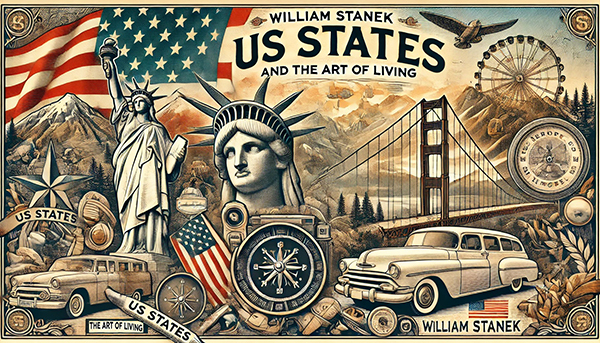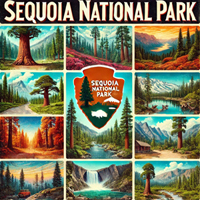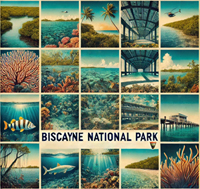

William and Hui Cha Stanek have explored America’s diverse states, uncovering their rich history, vibrant cultures, and breathtaking landscapes. Their guides go beyond destinations, capturing the essence of each place through personal experiences and hand-crafted artwork. These artistic interpretations invite you to connect with each state in a unique way and discover its beauty for yourself.
National Parks Index | US Itineraries Index | American Roadtrips Index

Bring home a Bugville Critters book and watch as your child's love for reading and learning grows with every page. Hand-painted illustrations bring the heartwarming stories to life. Ask your librarian to add Bugville Critters to the library's digital collection today!
Discover William Stanek's Exclusive Art Collection
Explore and purchase the stunning art featured on this site. Own a piece of William Stanek's unique and captivating artwork today!

(May 2, 2025) At a Glance - Travel Planning Guide for North Carolina
Planning Your North Carolina Adventure
Our detailed North Carolina travel and weather guides offer comprehensive information on the best times to visit, weather expectations, and valuable tips for various regions across the states. Whether you're exploring vibrant cities, stunning national parks, or charming small towns, these insights will help you plan your trips for unforgettable experiences. Here's a snapshot of what you can expect:
Optimal Visiting Times: Discover the ideal seasons to visit each location, ensuring you experience the most pleasant weather and avoid peak tourist crowds.
Weather Expectations: Get a clear understanding of seasonal temperatures, rainfall patterns, and climate nuances to help you pack appropriately and plan activities.
Additional Tips: Benefit from insider advice on local attractions, must-see landmarks, and practical travel tips to enhance your journey.
North Carolina: Explore North Carolina's stunning coastlines, majestic mountains, and vibrant cities like Raleigh and Charlotte.
Western North Carolina (Including Asheville, the Blue Ridge Mountains, and the Great Smoky Mountains)
Optimal Times of Year:
- Spring (April to June): Spring is a beautiful time to visit Western North Carolina, with mild temperatures, blooming wildflowers, and lush greenery. It's an ideal time for hiking and exploring the Blue Ridge Parkway.
- Fall (September to November): Fall is arguably the best time to visit, with cooler temperatures and spectacular fall foliage. The region's mountains are particularly stunning, and it's a popular time for scenic drives and hiking.
- Summer (June to August): Summer is warm, making it a great time for outdoor activities like hiking, rafting, and visiting waterfalls. The higher elevations provide a cooler escape from the heat.
Temperature:
- Daytime Highs: Range from 50 ° F to 85 ° F (10 ° C to 29 ° C) depending on the season.
- Nighttime Lows: Typically between 30 ° F and 65 ° F (-1 ° C to 18 ° C).
Rainfall:
- Spring and Fall: Moderate rainfall, averaging 3-4 inches per month.
- Summer: Higher rainfall, with frequent afternoon thunderstorms, averaging 4-6 inches per month.
- Winter: Lower rainfall, with occasional snow in higher elevations, averaging 2-3 inches per month.
Local Cuisine:
- Mountain Trout: Fresh, locally caught trout is a specialty, often grilled or fried and served with local vegetables.
- Apple Dishes: Western North Carolina is known for its apple orchards. Try apple cider, apple butter, or an apple pie.
- BBQ: North Carolina-style barbecue, particularly pulled pork with a vinegar-based sauce, is a must-try.
Cultural Etiquette:
- Respect for Nature: The mountains and forests of Western North Carolina are cherished by locals. Practice leave-no-trace principles and respect the environment.
- Mountain Culture: The region has a rich Appalachian culture. Show respect for local traditions, music, and crafts, particularly in areas like Asheville.
Safety:
- Mountain Weather: Weather can change rapidly in the mountains. Be prepared with proper gear, especially when hiking at higher elevations.
- Wildlife Awareness: Bears are common in this region. Store food securely when camping, and be aware of your surroundings.
Hidden Gems:
- Pisgah National Forest: A beautiful area for hiking, with waterfalls, scenic views, and abundant wildlife.
- Biltmore Estate: Located in Asheville, this historic mansion and its gardens offer a glimpse into the Gilded Age, along with stunning views of the surrounding mountains.
Central North Carolina (Including Raleigh, Durham, Greensboro, and the Piedmont Triad)
Optimal Times of Year:
- Spring (March to May): Spring is a pleasant time to visit Central North Carolina, with mild temperatures and blooming flowers, particularly in gardens and parks. It's also a good time for attending outdoor festivals and events.
- Fall (September to November): Fall offers cooler temperatures and beautiful fall foliage, making it a great time for outdoor activities and visiting historical sites.
- Summer (June to August): Summer is warm to hot, with many opportunities for outdoor activities and festivals. However, the heat and humidity can be intense, particularly in July and August.
Temperature:
- Daytime Highs: Range from 50 ° F to 90 ° F (10 ° C to 32 ° C) depending on the season.
- Nighttime Lows: Typically between 30 ° F and 70 ° F (-1 ° C to 21 ° C).
Rainfall:
- Spring and Fall: Moderate rainfall, averaging 3-4 inches per month.
- Summer: Higher rainfall, with occasional thunderstorms, averaging 4-5 inches per month.
- Winter: Lower rainfall, with occasional snow or ice, averaging 2-3 inches per month.
Local Cuisine:
- Lexington-Style BBQ: Central North Carolina is known for its vinegar-based barbecue sauce, especially with pulled pork.
- Sweet Tea: A Southern staple, sweet tea is commonly served with meals throughout the region.
- Pimento Cheese: Often referred to as the "caviar of the South," pimento cheese is a spread made from cheese, mayonnaise, and pimentos, commonly served on sandwiches or crackers.
Cultural Etiquette:
- Southern Hospitality: Central North Carolina is known for its friendly and welcoming residents. Politeness and good manners are highly valued.
- College Rivalries: The Triangle (Raleigh, Durham, Chapel Hill) is home to major universities with strong sports rivalries. Respect local pride, particularly during basketball season.
Safety:
- Hurricane Awareness: Central North Carolina can be affected by hurricanes in the fall. Stay informed about weather conditions and have a plan in place.
- Heat Precautions: Summers can be hot and humid. Stay hydrated, wear sunscreen, and avoid strenuous outdoor activities during peak heat.
Hidden Gems:
- Sarah P. Duke Gardens: Located in Durham, these beautifully maintained gardens are perfect for a leisurely stroll or a picnic.
- Old Salem: A living history museum in Winston-Salem, offering a glimpse into early American life in a Moravian settlement.
Eastern North Carolina (Including the Outer Banks, Wilmington, and the Coastal Plain)
Optimal Times of Year:
- Spring (April to June): Spring is an ideal time to visit Eastern North Carolina, with mild temperatures and blooming azaleas. It's perfect for exploring coastal towns and enjoying outdoor activities before the summer crowds arrive.
- Fall (September to November): Fall is another excellent time to visit, with cooler temperatures, fewer tourists, and still-warm ocean water. It's great for beach activities and exploring the Outer Banks.
- Summer (June to August): Summer is peak season, particularly in the Outer Banks and Wilmington. The weather is warm to hot, ideal for beach vacations, water sports, and coastal exploration.
Temperature:
- Daytime Highs: Range from 55 ° F to 90 ° F (13 ° C to 32 ° C) depending on the season.
- Nighttime Lows: Typically between 40 ° F and 75 ° F (4 ° C to 24 ° C).
Rainfall:
- Spring and Fall: Moderate rainfall, averaging 3-4 inches per month.
- Summer: Higher rainfall, with frequent thunderstorms and occasional hurricanes, averaging 4-6 inches per month.
- Winter: Lower rainfall, with minimal snow, averaging 2-3 inches per month.
Local Cuisine:
- Calabash Seafood: Named after the town of Calabash, this style of seafood is lightly battered and fried, and it's a must-try along the coast.
- Hushpuppies: These deep-fried cornmeal balls are a common side dish, often served with seafood.
- Eastern-Style BBQ: Differing from the western style, Eastern North Carolina BBQ uses a vinegar and pepper-based sauce, typically on whole hog pork.
Cultural Etiquette:
- Beach Respect: The Outer Banks and other coastal areas are popular destinations. Follow beach rules, including littering policies and respecting quiet hours.
- Maritime Heritage: Eastern North Carolina has a strong maritime culture. Respect local traditions, particularly in fishing communities.
Safety:
- Hurricane Season: Eastern North Carolina is highly vulnerable to hurricanes, particularly from June to November. Have an evacuation plan and stay updated on weather conditions.
- Rip Currents: Be cautious of rip currents when swimming in the ocean. Always swim near lifeguards and know how to respond if caught in a current.
Hidden Gems:
- Cape Hatteras National Seashore: A beautiful, unspoiled stretch of coastline perfect for beachcombing, fishing, and wildlife viewing.
- Tryon Palace: Located in New Bern, this historic site includes a restored governor's mansion, gardens, and historic homes, offering a glimpse into colonial life.

Step into a world of timeless beauty with our premium, oversized hardcover book - crafted for discerning collectors and anyone who values the power of art. Perfect for your coffee table, it's more than just a book; it's a conversation starter, a window into over 30 years of William's visionary photography.
Your Support Matters
Purchasing artwork from William Stanek's collection not only brings beauty into your life but also helps us continue to share. Thank you for supporting our creative journey!

Support The Lights of Paris by Robert Stanek, William Stanek's pen name! Through vivid historical detail and deeply moving character stories, Robert takes readers on an unforgettable journey through one of history’s most transformative times.












